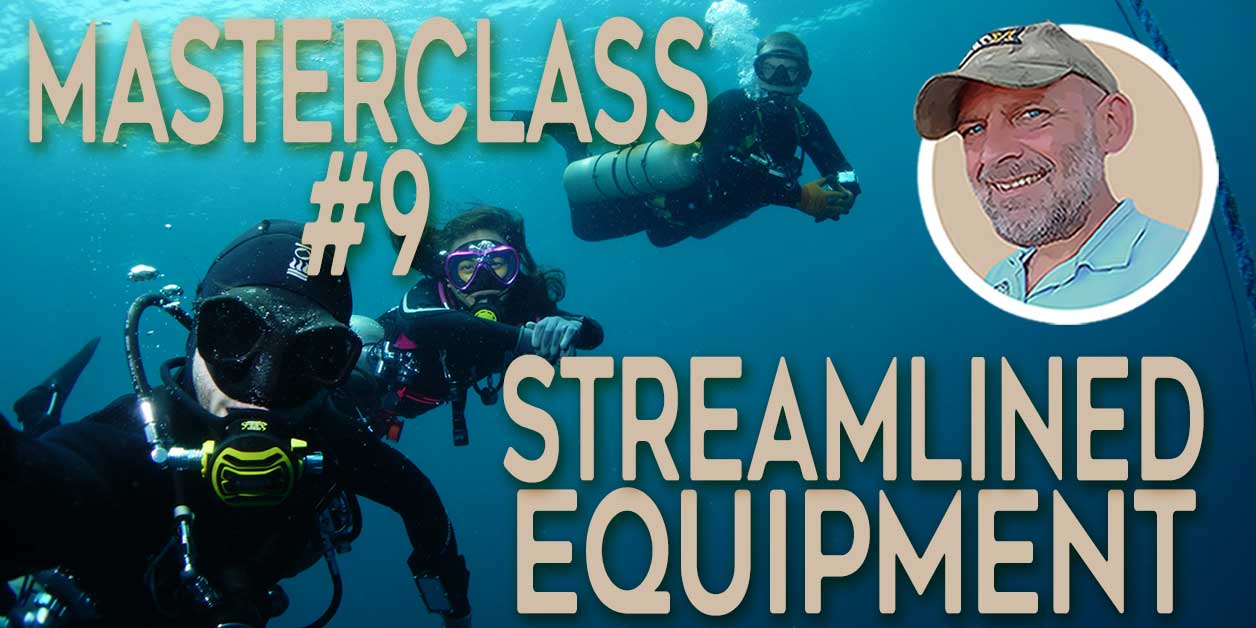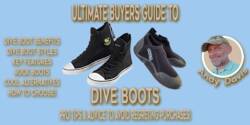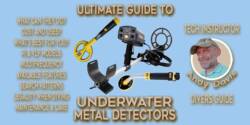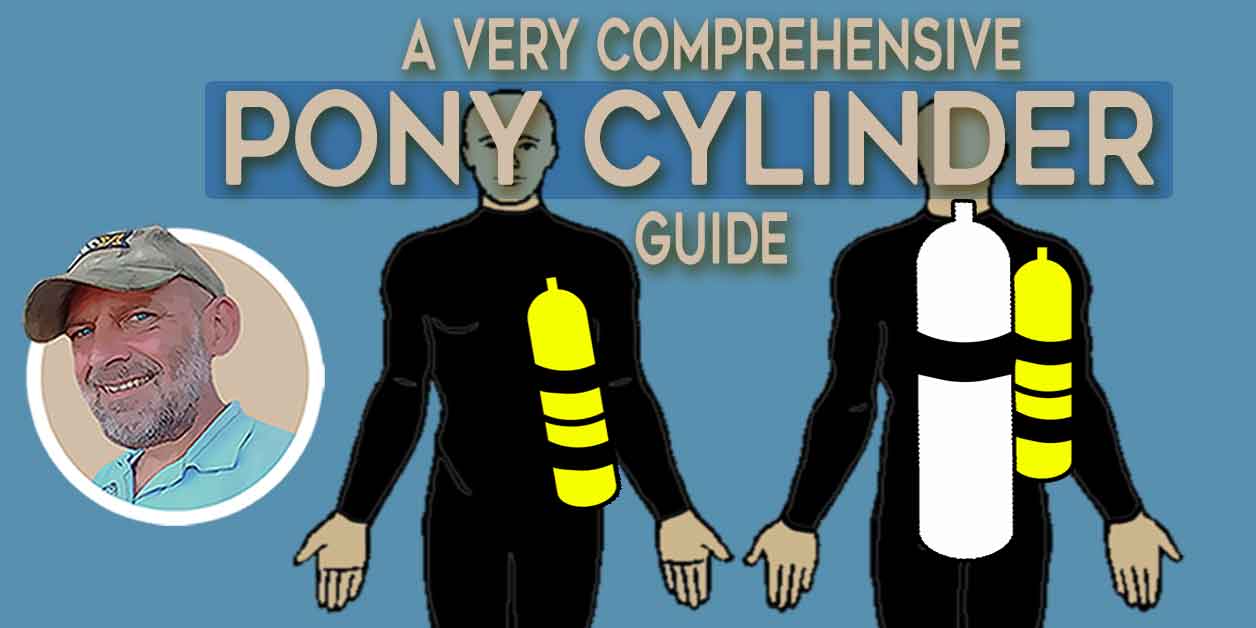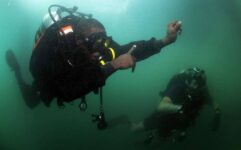Backplate & Wing BCDs for Scuba Diving: Ultimate Guide To BP&Ws
Scuba diving has evolved over the years, with advancements in equipment design catering to the needs of both recreational and technical divers. One such innovation that has gained popularity is the Backplate & Wing (BP&W) BCD system. This comprehensive guide delves into the features, benefits, and considerations associated with Backplate and Wing BCDs for scuba diving.
My Personal Experience With Backplate & Wing BCDs
I have used BP&W BCDs since the early 2000’s, and I personally feel that they are superior to traditional jacket-style BCDs in almost every way. Yes, they do require some attention to detail with the setup and sizing; but, once that is done, they have so many benefits.
In contrast, jacket-style BCDs have just one main advantage. They are familiar because most divers use them during Open Water training. Whilst familiarity may have some short-term advantages, it isn’t enough to justify a longer-term purchasing decision.
I started out with a single-tank backplate & wing system as a recreational diver. I’ve owned 3 different versions over the years; 30lb Halcyon Eclipse and an 18lb Oxycheq tropical wing. When I became a technical diver, over 20 years ago, I bought a Custom Divers TDB doubles wing. That was eventually replaced with a Halcyon Evolve. I now dive with an XDeep NX Project doubles wing.
Understanding the Backplate & Wing System
A Backplate and Wing BCD is a buoyancy control system that offers divers a streamlined and customizable setup. It consists of three main components:
1. The BP&W Backplate
The backplate serves as the core of the system and is usually crafted from materials such as stainless steel and aluminum. While titanium and carbon fiber options exist, they are less common and have a large price tag.
The backplate provides stability and support, distributing weight above the diver’s torso evenly. This helps to facilitate better horizontal trim.
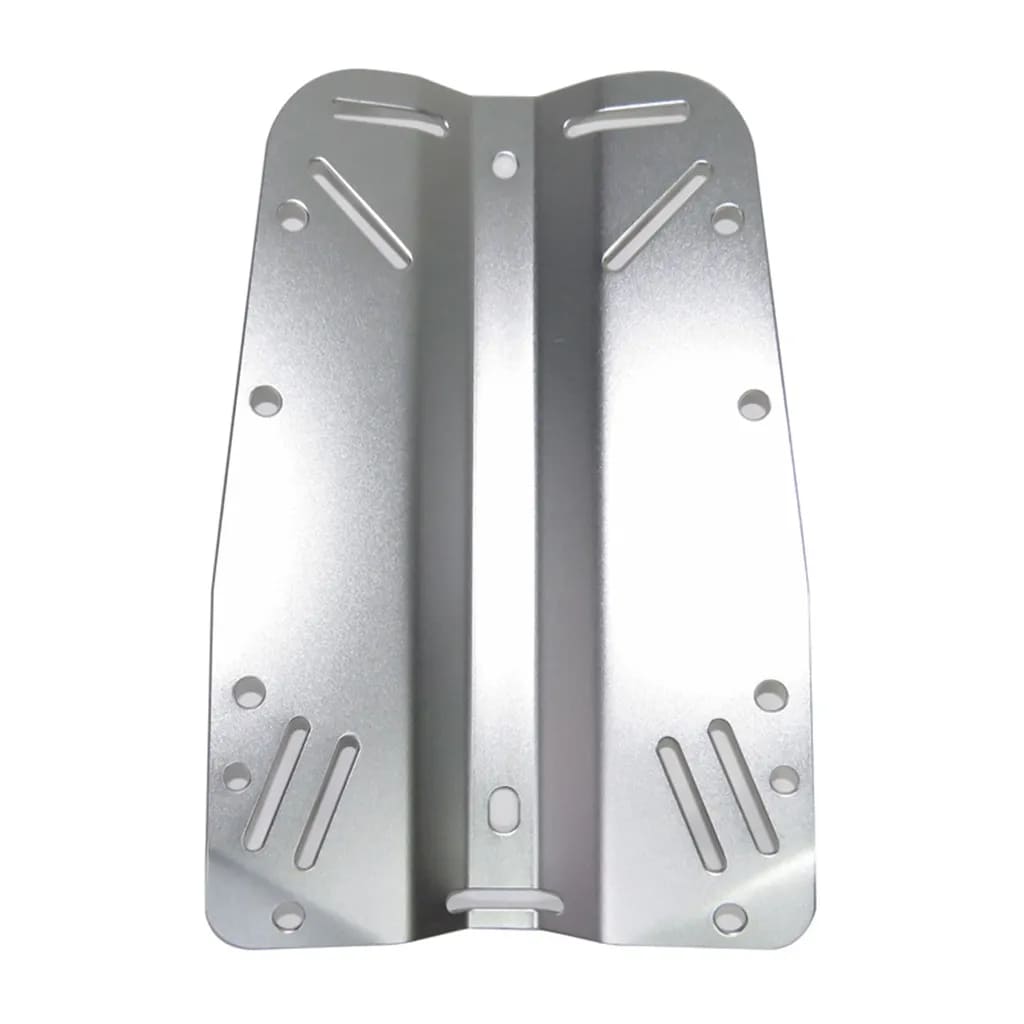
2. The Backplate & Wing Harness
The harness holds the entire system in place on the diver’s body. It is made of 2″ (5 cm) marine-grade webbing. There are varied options vary in terms of rigidity and color.
Some harnesses feature continuous webbing, while others utilize quick-release buckles for easy donning, doffing, and adjustment. These are often called “comfort” or “deluxe” harnesses by manufacturers, which is a tempting marketing ploy.
Very few experienced divers prefer the complexity of comfort or deluxe harnesses. Many are sold on eBay as divers resort to the simpler option.
Generally, I recommend starting off with a simple continuous webbing harness. This is known as a ‘Hogarthian’ harness.
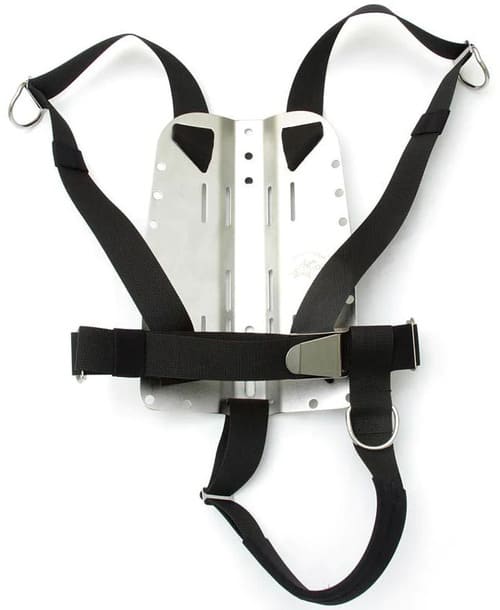
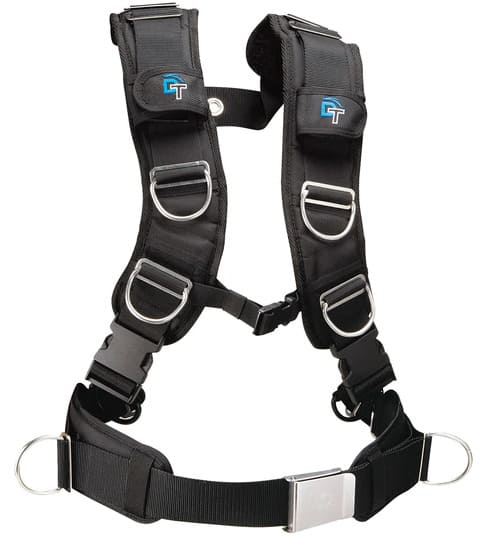
3. The BP&W Wing (Bladder)
The wing is responsible for providing buoyancy to the diver. These bladders come in different sizes and shapes, including single-cylinder or double-cylinder options. They play a crucial role in achieving buoyancy control and trim throughout the dive.
There are three main types of wings:
- Tropical wings for single-tank diving with less than 20lbs of lift
- Single-tank wings with 30-40lbs of lift
- Doubles wings with 40lbs+ of lift
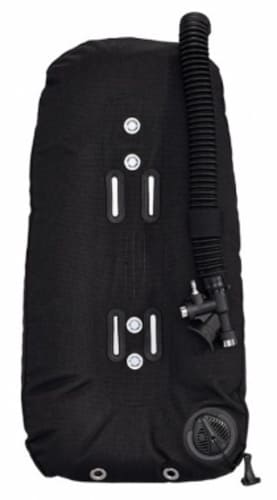
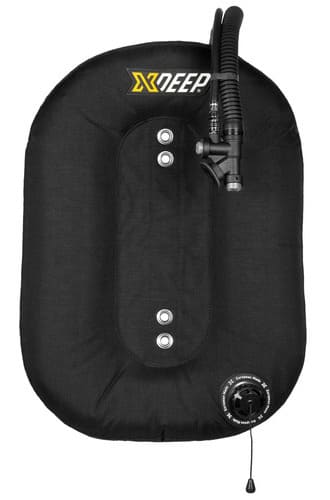
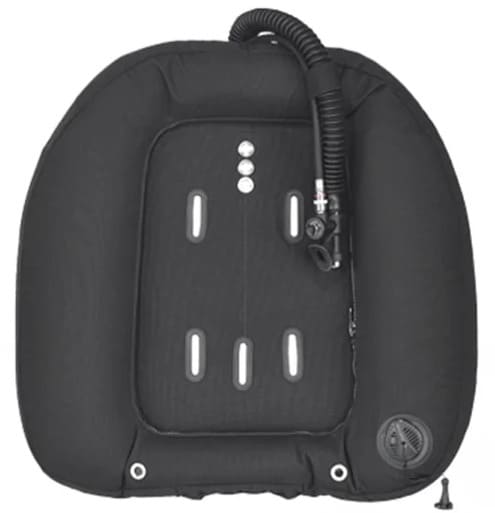
Doubles wings, used by technical and cave divers, can be either a ‘horseshoe’ or ‘donut’ design. Generally, the donut design is more modern, overwhelmingly popular, and offers better management of the gas in the wing.
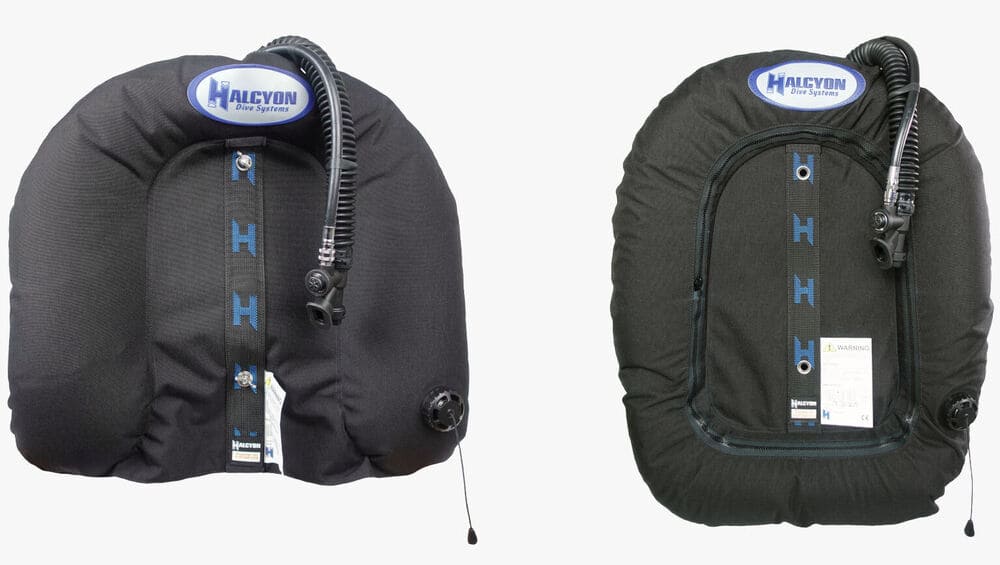
The KISS Principle and BP&Ws
Backplate & wing BCDs embrace the KISS principle, which stands for “Keep It Simple, Stup1d”. This emphasizes the importance of simplicity in design. It suggests that dive equipment should be kept straightforward and uncomplicated, avoiding unnecessary complexity.
This principle aims to make diving gear more understandable, manageable, and efficient by focusing on simplicity rather than over-complication. In turn, the diver will appreciate:
- Improved situational awareness
- More intuitive equipment familiarity
- Less stress during diving emergencies
8 Benefits of the KISS Principle in Dive Gear Design
- Ease of Understanding: Simple dive gear designs are easier for divers to comprehend intuitively.
- Efficiency: Simplicity often leads to more efficient skills and protocols.
- Faster Problem-Solving: Simplified dive gear designs allow for quicker identification and resolution of issues.
- Reduced Complexity: Complex systems can become difficult to manage, maintain, or modify. Simplicity helps avoid unnecessary intricacies.
- Improved Usability: Simple designs are more user-friendly, providing a better experience for users and minimizing the need for extensive deliberate practice.
- Lower Risk of Failures: Complex systems can introduce more failure points. Simplicity reduces those points of potential failure.
- Flexibility: Simple systems can be more adaptable to changes and updates, making them versatile and future-proof.
- Reduced Costs: Simpler solutions often require fewer materials and labor, resulting in cost savings.
Advantages of Backplate & Wing BCDs
Backplate and wing BCDs offer several main advantages for divers seeking enhanced control and customization:
- Streamlined Profile: The minimalist design reduces drag underwater, allowing for smoother movements and increased efficiency.
- Customizability: Divers can adjust the harness, backplate material, and wing capacity to perfectly suit their needs.
- Modularity: There are a vast array of optional add-ons, including; integrated and trim weight pockets, and equipment pouches.
- Buoyancy Control: The wing design facilitates better buoyancy control at various depths, enhancing the overall diving experience.
- Durability: Metal backplates and marine-grade webbing harnesses offer great durability and resistance to wear and tear. These systems last for decades of intensive use.
- Infinitely Adjustable: The harness system is one-size-fits all. Whatever your height or body shape, a BP&W is guaranteed to fit. It also grows with child divers over the years.
Common Myths About Backplate & Wing BCDs
There are a number of myths that circulate about BP&W BCDs. These normally originate from divers who are inexperienced or poorly trained in their use.
BP&W BCDs Push You Face Forwards At The Surface
It is true that backplate & wing BCDs can push you face forwards on the surface. However, this is avoided through two steps:
- Do not over-inflate the wing. Divers habitually fill jacket-style BCDs to the maximum when at the surface. With a backplate & wing you should only fill it with enough gas necessary for comfortable flotation.
- Calculate and position your weighting effectively. The use of trim weights on the rear cam-bands helps eliminate the tendency to go face forwards. Additionally, do not use integrated weight systems on the BCD waist belt – or, at least, don’t put too much weight into them.
BP&W BCDs Are Only For Technical Divers
There is nothing inherently ‘technical’ about a backplate & wing BCD. They are designed for utmost simplicity and minimalism. However, technical divers do value that simplicity in their gear. Recreational scuba divers benefit just as much from simple gear designs.
Metal Backplates Must Be Uncomfortable
If you’ve never dove a backplate & wing BCD, it is easy to assume that the metal backplate might be uncomfortable against your back. Actually, there is very little weight loading on the backplate when you are underwater. As a result, you really don’t feel anything annoying; even if only diving in a rash guard.
Very few backplate & wing divers have concerns about discomfort with the backplate. However, if it was somehow an issue, you can buy backplate comfort pads to add some foam padding.
Pros and Cons of Backplate & Wing vs. Jacket BCDs for Scuba Diving
When it comes to choosing the right Buoyancy Control Device (BCD) for scuba diving, divers are often faced with the decision between a Backplate and Wing setup and the traditional Jacket-style BCD. Each option has its own set of advantages and disadvantages, catering to different preferences and diving styles. Let’s explore the pros and cons of both systems to help you make an informed choice.
Pros of Backplate & Wing BCDs
- Streamlined Profile: Backplate and Wing systems provide a more streamlined profile underwater. This minimizes drag, making it easier to move through the water, and reduces gas consumption.
- Customizability: Divers can adjust the harness, backplate, and wing for a personalized fit, ensuring optimal weight distribution and comfort.
- Modularity: These systems are versatile, allowing divers to reconfigure them for different diving needs. They can easily accommodate additional gear and tanks, making them a popular choice for technical divers.
- Durability: Stainless steel or aluminum backplates offer durability and resistance to wear and tear, making them suitable for challenging diving environments.
- Consistent Fit: Inflating or deflating the wing bladder does not affect the fit of the BCD.
- Fewer Entanglement Points: For cave and wreck divers, a BP&W has a cleaner profile, with fewer components that can be snagged and cause entanglement.
- Technical Diving: Backplate and wing systems are favored by technical divers due to their simplicity, modularity, and ability to accommodate additional tanks and equipment. Gaining familiarity with a single-tank BP&W has advantages if later transitioning to a double-tank wing for technical or cave diving.
Cons of Backplate & Wing BCDs
- Configuration: For beginners, a backplate & wing system requires some attention to detail with the sizing and adjustment. This is not necessary with jacket BCDs.
Jacket-style BCDs
Jacket-style BCDs are the traditional choice, widely used, and recognized by divers. The bladder of a jacket-style BCD inflates on all sides, encompassing the diver’s body.
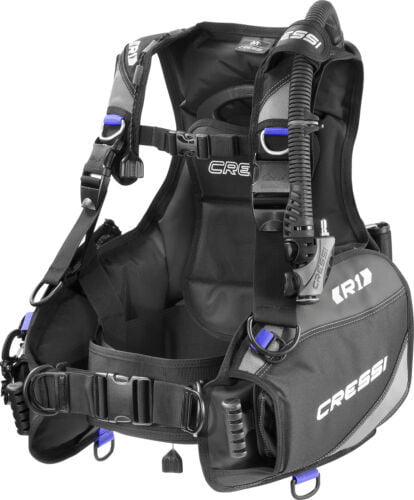
Pros of Jacket-Style BCDs
- Familiarity: Jacket-style BCDs offer a sense of familiarity for many divers, as this is what they are likely to have learned to dive with.
Cons of Jacket-Style BCDs
- Bulkiness: Jacket-style BCDs are typically much bulkier compared to backplate & wing systems. This takes up more space in luggage when traveling.
- Poor Streamlining: The design of jacket-style BCDs causes far more water resistance than a backplate & wing design. Consequently, they require more exertion and cause more air consumption.
- Horizontal Trim: Achieving horizontal trim can be more challenging with jacket-style BCDs because gas cannot be consistently leveled relative to the diver’s torso.
- Little or No Customization: While some jacket-style BCDs offer pockets and features, they are not customizable or modular like backplate & wing systems.
- Varying Fit: Jacket-style BCDs change their fit as you add or remove gas from the bladder. They can be tight when fully inflated, but become loose when empty.
The decision between a backplate & wing BCD and a jacket-style BCD ultimately depends on your diving preferences, experience level, and the type of diving you plan to do.
Consider factors such as fit, comfort, buoyancy control, and the need for customization. Both systems have their merits, and the best choice for you will align with your individual diving goals.
Choosing Your Backplate & Wing BCD
When selecting a backplate and wing BCD there are three main options that you will have to decide upon:
- Backplate material
- Wing size
- Harness type
The sections below describe what those options are, and how to choose which best suits your individual needs.
What wing do I need for my BCD?
Wings are either designed for doubles or singles. Single tank wings aren’t wide enough for doubles. In contrast, doubles wings will taco horrendously if used with a single cylinder; and that poses safety risks, in addition to being unpleasant to dive.
As a very general rule of thumb:
- <20lbs wing for aluminum tanks in warm water
- 30lbs wing for cold water with steel cylinders
- 40lbs wing for very large capacity steel tanks
Ideally, you should actually calculate your wing lift requirement. This needs to factor in your exposure protection and weighting.
Calculating Your BP&W wing lift requirement
It may feel intuitive to believe that a larger wing is better. However, there are drawbacks to using a larger-than-necessary wing.
- Larger wings allow more gas migration around the wing. This can cause instability.
- Bigger wings will ‘taco’ around the cylinder, making it harder to keep gas where you need it, or more difficult to dump it.
A diver is most negatively buoyant after their initial descent on a dive. The cylinder/s are still full of gas, and the wetsuit (if used) will be compressed. The wing needs enough lift capacity to support the diver at this time.
- Start with a proper buoyancy check. That involves holding a shallow stop with minimum reserve gas and no air in your BCD. Adjust your weighting so that you’re inherently neutral on that stop.
- Once properly weighted, you can ascertain the weight of gas in your cylinders, and the amount of wetsuit buoyancy.
- The weight of gas can simply be referenced from cylinder manufacturer data. This is published online.
- Wetsuit buoyancy, if applicable, can be determined by simply putting the suit in a mesh bag and weighting that bag until it just begins to sink.
- Add those two figures together and you’ll have the minimum wing lift capacity necessary. This ensures you can attain neutral buoyancy at depth from the outset of your dive.
You’ll only lose negative buoyancy thereafter, as you consume gas. You should be ascending with almost no gas in your wing; which has the direct benefit of making precise buoyancy and ascent rate control very easy.
The best BP&W backplate for your diving needs
Deciding between steel, aluminum, and carbon fiber backplates for scuba diving involves considering several factors to determine the most suitable option for your diving preferences and needs. Here are some key points to help you make an informed decision:
Backplate Weight
- Steel backplates are heavier, providing inherent negative buoyancy. They are favored by drysuit divers who need additional weight.
- Aluminum backplates are lighter than steel, offering reduced weight but less integral weight. They are a good choice for travelers and warm-water divers who use aluminum tanks.
- Carbon fiber backplates are extremely lightweight and have neutral buoyancy. They’re ideal for traveling divers seeking absolute minimal weight.
It is also worth noting that aluminum and steel backplates are also available with skeletonized designs. These offer reduced weighting.
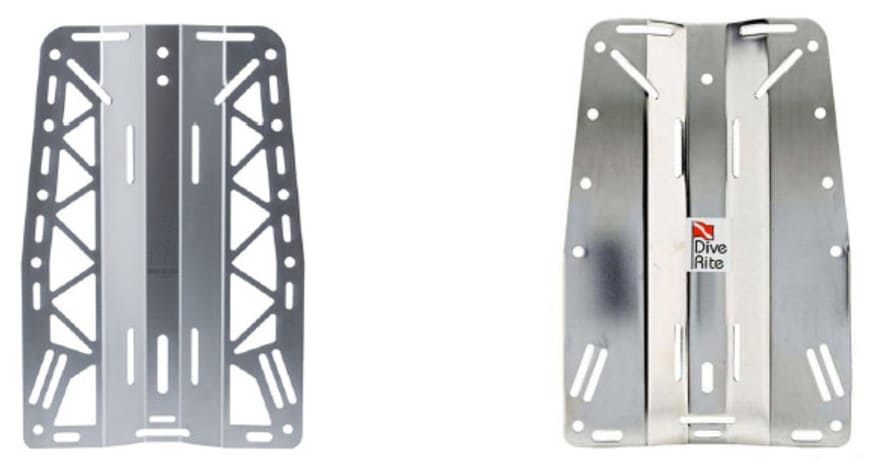
BP&W Backplate Weight Ranges (Approximate):
- Steel Backplates: Generally range from 2.5 kg to 4 kg (5.5 lbs to 8.8 lbs) or more.
- Aluminum Backplates: Typically weigh around 0.9 kg to 1.5 kg (2 lbs to 3.3 lbs).
- Carbon Fiber Backplates: Can weigh approximately 0.5 kg to 1 kg (1.1 lbs to 2.2 lbs).
Travel Considerations: If you frequently travel for diving, a lightweight option like aluminum or carbon fiber may be preferable due to their reduced weight. You can add separate trim weight pockets to make up the weighting difference, if necessary.
Backplates and the Balanced Rig Principle
In terms of backplate material, you need to read about the balanced rig principle. Whilst the backplate does remove lead from your weight belt, it is imperative that you still retain the capacity to jettison enough ballast for positive buoyancy.
Getting the right balance between your integral and jettisonable weighting, along with the buoyancy properties of your other gear is called the balanced rig principle:
Backplate Durability
- Stainless steel backplates are durable and can withstand rough handling, making them suitable for technical and rugged diving environments.
- Aluminum backplates are less durable than steel but still offer decent strength. They are suitable for recreational divers and those who prioritize weight reduction.
- Carbon fiber backplates are known for their exceptional strength-to-weight ratio. They offer impressive durability but may require careful handling to prevent damage.
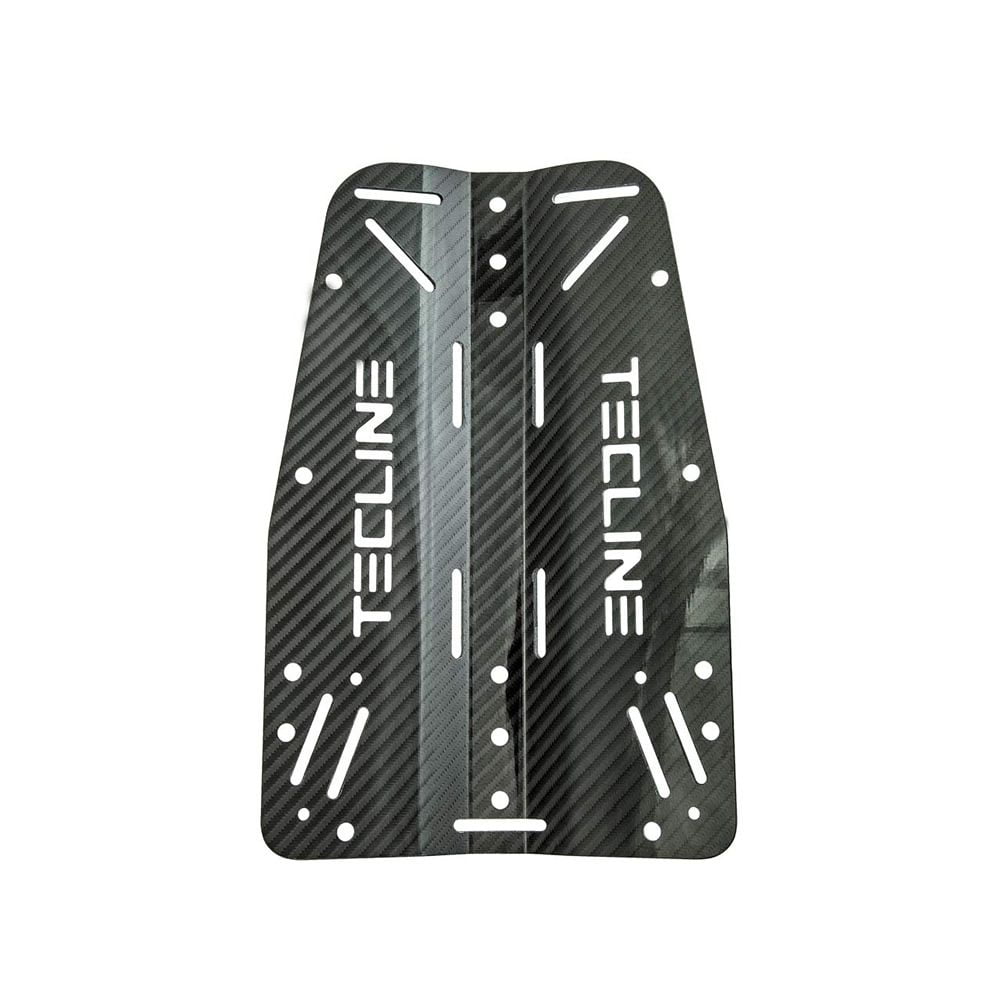
Backplate Cost
- Steel and aluminum backplates are more affordable compared to carbon fiber and titanium options.
- Carbon fiber backplates are usually the most expensive due to their advanced manufacturing process and lightweight properties.
Remember that each material has its advantages and disadvantages, and the “best” choice depends on your individual preferences, diving style, and priorities. Ultimately, the decision should align with your comfort, diving goals, and budget.
How to Set Up and Configure a Backplate & Wing BCD
Setting up and configuring a backplate and wing BCD for scuba diving involves careful attention to detail and ensuring that each component is optimized for safety and comfort. Let’s dive into the step-by-step process of assembling this diving system.
The Harness and Backplate
The foundation of a backplate and wing BCD setup is the harness and backplate. To ensure maximum safety, it’s ideal to rig the harness from one single piece of webbing without any quick-release buckles or potential failure points.
Although quick-release buckles may seem convenient, they can increase the risk of equipment failure underwater. It pays dividends to prioritize a secure and streamlined harness.
The crotch strap, a crucial component, prevents the diving system from sliding upwards during entry into the water or inversion. It’s necessary for maintaining proper positioning and also becomes important when using a diver propulsion vehicle (DPV).
Backplate & Wing Cylinder Attachment
Depending on your diving setup, you’ll need to attach the harness system to the cylinders.
- For single tanks, a single tank adaptor can be used to position the Backplate and Wing BCD between the plate and the tank. Some single-tank BP&Ws are designed with an integral single-tank adaptor.
- For double cylinders, the backplate is bolted to the cylinders with a buoyancy wing between them.
Equipment Attachment and D-Rings
The backplate and wing harness focuses on simplicity and efficiency. It features strategically placed D-rings that cater to specific needs.
- Chest D-rings, slightly bent for easy clipping, allow for bottle attachment.
- The hip D-ring is versatile for attaching pressure gauges, stage bottles, and other gear.
- Crotch strap D-rings accommodate DPV attachment and towing, while rear crotch strap D-rings are used for gear that’s being towed, or for DSMB and spool stowage.
Back-Up Lights and Accessories
When configuring your Backplate and Wing BCD, consider the placement of accessories. A small knife should be positioned in an open sheath on the waist belt, accessible by either hand. Placing the knife to the left of the crotch strap ensures easy deployment.
Back-up lights are attached to the shoulder D-rings, with one light per side. A rubber band secures them neatly to the webbing, making them accessible but out of the way. These lights can be turned on without unclipping them from the D-rings, a practical advantage that enhances safety during emergencies.
Fitting a Backplate & Wing Harness
Setting up and sizing a backplate and wing BCD harness requires careful attention to detail, and the information you’ve provided from various sources is invaluable. Let’s go through the steps and considerations to ensure a comfortable and safe fit:
Minimum Materials Required:
- 3x Stainless Steel D-rings (2 Bent and 1 Regular)
- Backplate
- 5x Stainless Steel Tri-Glides
- 12ft (4m) 2-inch Harness Webbing (continuous weave)
- 1x Stainless Steel Buckle
- 2x Bicycle Tire Tubing (1-2′ inch” segments)
- Personal Accessories (additional D-rings, weight or stowage pockets, cushioned shoulder straps, etc.)
- 1x Crotch Strap
- Single Tank Adaptor (STA) *depending on wing design
- 1 or 2 (ideally) cam bands *for single-tank systems
Assembly Steps:
- Start by placing the backplate face down on a suitable surface.
- Attach the harness webbing to the backplate using the appropriate hardware.
- Thread the harness webbing through the slide bars (Tri-Glides) and adjust them according to your preference.
- Attach the D-rings and other hardware to the harness webbing as needed.
- Attach the crotch strap with D-ring to the bottom of the backplate.
- Thread the bicycle tire tubing segments onto the harness webbing to keep it organized and prevent excess webbing from dangling.
- Attach the bungee loop and other personal accessories based on your preferences and needs.
Sizing and Fit:
- The key is to ensure a snug fit with a few important considerations.
- Shoulder straps should be loose enough to slip your fist underneath.
- The crotch strap should be snug when standing upright.
- Shoulder D-rings should be positioned at the level matching your outstretched arms.
- Both hands should touch the top of the backplate when reaching back, The top of the plate just below the protruding C7 vertebrae.
- The left hip D-ring should be centered on the side of your torso.
- The waist buckle should be on the right side of the crotch strap, leaving room for additional buckles (e.g., for a primary light canister).
Remember, proper sizing and fitting ensure comfort and safety while diving. If you’re new to this setup, consider seeking assistance from suitably experienced divers or instructors to ensure you get it just right. Technical diving qualifications are usually a good indicator that someone knows how to configure a BP&W system.
A well-fitted backplate and wing BCD harness enhance your diving experience, making it more enjoyable and efficient underwater.
Backplate & Wing Add-Ons
When configuring a backplate & wing BCD, there are some optional add-ons you can consider:
Single-Tank Adaptor
If your BP&W does not have an integrated single tank adaptor (STA), you will need to purchase one separately.
Backplate Pad
These offer some padding from a metal backplate. Although few BP&W divers observe any discomfort when diving this type of BCD. Some pads have a built-in storage slot for DSMBs. These pads simply screw onto the backplate.
Integrated Weight Pockets
You can opt to dispense with using a traditional weight belt and, instead, add an integrated weight system onto your backplate & wing BCD. These aren’t very necessary for warm water divers, as the backplate itself can cover the majority of your weighting needs.
Trim Weight Pockets
You can add 1 or 2 pairs of trim weight pockets to your BCD cambands. These are a good solution when you need just a little extra weight. They also help maintain natural horizontal trim in the water.
Utility or Mask Pockets
You can add additional pockets to the waist belt of your backplate & wing BCD. These can hold a spare backup mask or other equipment in a steamlined way. However, most experienced BP&W divers prefer to use thigh pockets glued/sewn onto their wetsuit or drtsuit..
Is a Backplate & Wing BCD Right For You?
Backplate & Wing BCDs offer a versatile and customizable option for divers seeking improved buoyancy control and a streamlined profile.
Their modularity, durability, and adaptability make them an excellent choice for both recreational and technical divers.
By considering factors like wing lift, harness type, backplate material, and price, divers can select an ideal system that caters to their unique preferences and needs, enhancing their safety and enjoyment underwater.
FAQs About Backplate & Wing BCDs
While these systems require some initial configuration, they are suitable for divers of varying experience levels.
BP&Ws do not force you forward at the surface if you do not over-inflate the wing. Unlike Jacket BCDs, don’t fully inflate the wing; add just enough gas for comfortable flotation.
Yes, these systems are totally modular, so you can add attachment points, pockets, and integrated weight options.
BP&W BCDs are modular, comprising of a backplate, rear wing and webbing harness. Whereas, jacket-style BCDs use a wrap-around bladder and are not modular.
BP&W BCDs are modular, more streamlined, low bulk, have less failure points, are less prone to entanglement, and better promote innate horizontal trim. Additionally, weighting is incorporated into the backplate, rather than a weight belt.
The three main types of diving BCD are the Jacket-style BCD, the Backplate & Wing (BP&W) BCD, and the Rear-Inflate BCD.
About The Author

Andy Davis is a RAID, PADI TecRec, ANDI, BSAC, and SSI-qualified independent technical diving instructor who specializes in teaching sidemount, trimix, and advanced wreck diving courses.
Currently residing in Subic Bay, Philippines; he has amassed more than 10,000 open-circuit and CCR dives over three decades of challenging diving across the globe.
Andy has published numerous diving magazine articles and designed advanced certification courses for several dive training agencies, He regularly tests and reviews new dive gear for scuba equipment manufacturers. Andy is currently writing a series of advanced diving books and creating a range of tech diving clothing and accessories.
Prior to becoming a professional technical diving educator in 2006, Andy was a commissioned officer in the Royal Air Force and has served in Iraq, Afghanistan, Belize, and Cyprus.
In 2023, Andy was named in the “Who’s Who of Sidemount” list by GUE InDepth Magazine.
Purchase my exclusive diving ebooks!
Originally posted 2023-08-11 17:55:44.







